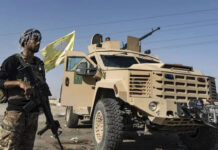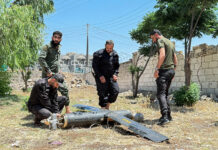
In a worrying escalation of the Syrian conflict, Assad regime forces backed by Russia and Iran have reportedly increased their use of explosive-laden First-Person View (FPV) drones, also known as kamikaze or suicide drones, against civilian targets in the liberated north of the country.
Syrian Civil Defense, also known as the White Helmets, has documented a worrying rise in drone attacks this year. They report over 60 attacks targeting civilian areas since the beginning of 2024, resulting in at least 11 civilian deaths and 32 injuries, including children and women.
Today the Assad regime involved a suicide drone targeting a civilian car in Darat Izza, injuring five civilians, including two children and a woman, all from the same family. The White Helmets further emphasize the devastating impact these attacks have on livelihoods and basic services. Targeting villages, towns, farmers, and agricultural areas disrupts food production and access to necessities, further exacerbating the already dire humanitarian situation in northwestern Syria.
This tactic bears a chilling resemblance to the Assad regime’s use of barrel bombs in the early years of the conflict. Barrel bombs are crude, unguided explosive devices dropped from helicopters on civilian areas, causing widespread devastation and indiscriminate casualties.
The Fatah al-Mubeen Operations Room (FOMR), recently issued a statement detailing the operating procedures of these drones and outlining steps civilians can take to mitigate the danger. The FPV drones used by the Assad regime rely on a spotter drone to identify targets before launching their attack. Unlike more sophisticated military drones, these FPV drones lack GPS guidance systems. Their lightweight limits them to low altitudes, around 35 meters, and their range is also restricted to approximately 10 kilometers.
FMOR’s statement highlights several key weaknesses of these drones. Their short flight time, limited to 9-15 minutes, puts pressure on launching attacks immediately to avoid battery depletion. Additionally, maintaining control of the drone requires an uninterrupted line of sight between the operator and the device. Finally, their low flight path makes them easier targets for those on the ground who are aware of the threat.
In addition to explaining how the drones function several recommendations were made to help civilians protect themselves from these drones. When traveling, prioritizing roads with natural barriers that can block drone signals is an important first step. Staying alert and listening to the distinct sound of the drones is crucial for taking cover. If a drone is spotted, seeking cover for 20 minutes should be sufficient time for the battery to run out. Participating in early warning networks established to monitor airspace activity can provide valuable warnings of approaching drones. Evacuation after a drone attack should be delayed if there are no casualties to avoid putting civilians at risk of follow-up strikes. In areas close to government-controlled zones, nighttime travel offers increased protection compared to daytime movement.
The increased use of FPV drones against civilians marks a dangerous turn in the Syrian conflict. While not as indiscriminate as barrel bombs, these targeted attacks still pose a significant threat to innocent lives.









